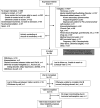Validation of the menstrual sensitivity index in adolescents
- PMID: 40787629
- PMCID: PMC12333772
- DOI: 10.1097/PR9.0000000000001315
Validation of the menstrual sensitivity index in adolescents
Abstract
Introduction: The Menstrual Sensitivity Index (MSI), assessing the attunement to and fear of menstrual symptoms, was recently developed and validated in an adult sample.
Objectives: The objective of this study was to validate the MSI in adolescents.
Methods: One hundred forty-one girls aged 13 to 19 participated in a larger parent study on primary dysmenorrhea, and their data were used in the present study. Girls participated at 2 timepoints: baseline (N = 141) and a 1-year follow-up (N = 115). At each timepoint, participants completed the MSI and a variety of self-report measures.
Results: A confirmatory factor analysis supports the previously identified factors of the MSI (somatic anxiety, fear/danger, and medication) in adolescent girls. The MSI demonstrates good item-total correlations, internal consistency, and test-retest reliability. The MSI converged most strongly with pain catastrophizing and diverged most strongly from body pain.
Conclusion: The MSI is a valid and reliable measure of attunement to and fear of menstrual symptoms in adolescents. Unlike research in adult women demonstrating convergence between the MSI and menstrual pain and menstrual symptom severity, the divergence between the MSI and these variables in the current study suggests that, for adolescents, menstrual sensitivity is more strongly related to fear of pain than menstrual pain itself. These findings provide considerations for future research and clinical practice addressing menstrual pain and symptoms in adolescents.
Keywords: Adolescents; Dysmenorrhea; Menstrual pain; Menstrual sensitivity; Scale development.
Copyright © 2025 The Author(s). Published by Wolters Kluwer Health, Inc. on behalf of The International Association for the Study of Pain.
Conflict of interest statement
L.A.P. has received consulting fees from Bayer Healthcare, Mahana Therapeutics, and Oregon Health & Science University and speaking fees from Brightside Health, Pacific Rehabilitation Centers, and The Concord Center. This study was supported by a grant from the National Institute of Child Health and Human Development (R01 HD093680; PI: L.A.P.).Sponsorships or competing interests that may be relevant to content are disclosed at the end of this article.
Figures
Similar articles
-
Progesterone or progestogen-releasing intrauterine systems for heavy menstrual bleeding.Cochrane Database Syst Rev. 2015 Apr 30;(4):CD002126. doi: 10.1002/14651858.CD002126.pub3. Cochrane Database Syst Rev. 2015. Update in: Cochrane Database Syst Rev. 2020 Jun 12;6:CD002126. doi: 10.1002/14651858.CD002126.pub4. PMID: 25924648 Updated.
-
Psychological therapies for the management of chronic and recurrent pain in children and adolescents.Cochrane Database Syst Rev. 2018 Sep 29;9(9):CD003968. doi: 10.1002/14651858.CD003968.pub5. Cochrane Database Syst Rev. 2018. PMID: 30270423 Free PMC article.
-
A New Measure of Quantified Social Health Is Associated With Levels of Discomfort, Capability, and Mental and General Health Among Patients Seeking Musculoskeletal Specialty Care.Clin Orthop Relat Res. 2025 Apr 1;483(4):647-663. doi: 10.1097/CORR.0000000000003394. Epub 2025 Feb 5. Clin Orthop Relat Res. 2025. PMID: 39915110
-
Pre-operative endometrial thinning agents before endometrial destruction for heavy menstrual bleeding.Cochrane Database Syst Rev. 2013 Nov 15;2013(11):CD010241. doi: 10.1002/14651858.CD010241.pub2. Cochrane Database Syst Rev. 2013. PMID: 24234875 Free PMC article.
-
Is Kinesiophobia Associated With Quality of Life, Level of Physical Activity, and Function in Older Adults With Knee Osteoarthritis?Clin Orthop Relat Res. 2025 Apr 1;483(4):667-676. doi: 10.1097/CORR.0000000000003278. Epub 2024 Oct 9. Clin Orthop Relat Res. 2025. PMID: 39387500
References
-
- Armour M, Parry K, Manohar N, Holmes K, Ferfolja T, Curry C, MacMillan F, Smith CA. The prevalence and academic impact of dysmenorrhea in 21,573 young women: a systematic review and meta-analysis. J Womens Health (Larchmt) 2019;28:1161–71. - PubMed
-
- Cameron L, Mikocka-Walus A, Sciberras E, Druitt M, Stanley K, Evans S. Menstrual pain in Australian adolescent girls and its impact on regular activities: a population-based cohort analysis based on longitudinal study of Australian children survey data. Med J Aust 2024;220:466–71. - PubMed
-
- Carlson KD, Herdman AO. Understanding the impact of convergent validity on research results. Organizational Res Methods 2012;15:17–32.
-
- Castarlenas E, Jensen MP, von Baeyer CL, Miró J. Psychometric properties of the numerical rating scale to assess self-reported pain intensity in children and adolescents: a systematic review. Clin J Pain 2017;33:376–83. - PubMed
LinkOut - more resources
Full Text Sources

